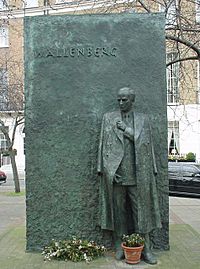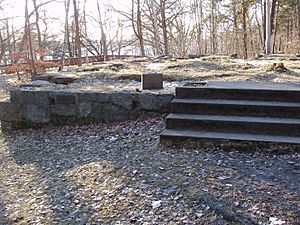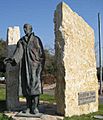Raoul Wallenberg facts for kids
Quick facts for kids
Raoul Wallenberg
|
|
|---|---|

Passport photo from June 1944
|
|
| Born |
Raoul Gustaf Wallenberg
4 August 1912 Lidingö Municipality, Sweden
|
| Disappeared | 17 January 1945 Budapest, Hungary |
| Died | Possibly 17 July 1947 (aged 34) or 31 July 1952 (aged 39) |
| Monuments | List |
| Nationality | Swedish |
| Alma mater | University of Michigan |
| Occupation | Businessman and diplomat |
| Known for | Rescuing Hungarian Jews from the Holocaust |
| Parent(s) | Raoul Oscar Wallenberg Maria Sofia "Maj" Wising |
| Relatives | Guy von Dardel (maternal half-brother) Nina Lagergren (maternal half-sister) Fredrik Elias August von Dardel (step-father) Nils Dardel (step-uncle) |
| Family | Von Dardel (stepfamily) Wallenberg family (biological father) |
| Awards | List |
Raoul Gustaf Wallenberg (born August 4, 1912 – disappeared January 17, 1945) was a Swedish architect, businessman, and diplomat. He was also a humanitarian, meaning he worked to improve people's lives. During World War II, he saved thousands of Jews in German-controlled Hungary. He protected them from German Nazis and Hungarian fascists.
From July to December 1944, Wallenberg worked as a special representative for Sweden in Budapest. He gave out special "protective passports." He also sheltered Jews in buildings he said were Swedish territory.
On January 17, 1945, during the Siege of Budapest, Wallenberg was taken by the Soviet Red Army. They suspected him of being a spy. He then disappeared. In 1957, Soviet officials said he died in prison in Moscow on July 17, 1947. They claimed he had a heart attack.
However, many people have questioned this. Some claimed to have seen him in Soviet prisons until the 1980s. The reasons for his arrest and death are still a mystery. In 2016, Sweden officially declared him dead. The date was set as July 31, 1952.
Wallenberg is honored for saving Hungarian Jews. In 1981, US Congressman Tom Lantos, who Wallenberg saved, helped make Wallenberg an honorary US citizen. He was the second person ever to receive this honor. Wallenberg is also an honorary citizen of Canada, Hungary, Australia, the UK, and Israel. Israel calls him one of the Righteous Among the Nations. Many monuments and streets around the world are named after him. The Raoul Wallenberg Committee of the United States gives an award each year to people who show his courage. He also received a Congressional Gold Medal from the United States Congress. Documents have shown that Wallenberg worked with the Office of Strategic Services (OSS). This was an early US intelligence agency.
Some people say Wallenberg saved 100,000 Jews. But historians believe the actual number is closer to 4,500 people. This number comes from Yad Vashem, a Holocaust memorial.
Contents
Early Life
Raoul Wallenberg was born in 1912 in Lidingö Municipality, near Stockholm, Sweden. His grandparents had a summer house there. His paternal grandfather, Gustaf Wallenberg, was a diplomat.
Raoul's parents were Raoul Oscar Wallenberg and Maria "Maj" Sofia Wising. His father was a Swedish naval officer. He died of cancer three months before Raoul was born. Raoul's maternal grandfather died three months after his birth. His mother and grandmother raised him together. In 1918, his mother remarried. She had two more children, Guy von Dardel and Nina Lagergren.
After high school, Wallenberg served in the Swedish military. Then, his grandfather sent him to study in Paris for a year. In 1931, he studied architecture at the University of Michigan in the United States. Even though his family was wealthy, he worked odd jobs. He even pulled a rickshaw at a fair in Chicago. He explored the US by hitchhiking. He wrote to his grandfather that hitchhiking taught him "diplomacy and tact."
Wallenberg knew he had a small amount of Jewish ancestry. It came from his great-great-grandfather, Michael Benedicks. He was proud of this heritage.
He finished college in 1935. His American degree did not let him work as an architect in Sweden. Later that year, his grandfather helped him get a job in Cape Town, South Africa. He worked for a Swedish construction company. After six months, he worked for a bank in Haifa.
In 1936, he returned to Sweden. He got a job at the Central European Trading Company in Stockholm. This company traded with central Europe. It was owned by Kálmán Lauer, a Hungarian Jew.
World War II
Starting in 1938, Hungary passed laws against Jews. These laws were like the ones in Germany. They limited jobs for Jews and banned marriage between Jews and non-Jews. Because of these laws, Wallenberg's business partner, Kálmán Lauer, found it hard to travel to Hungary. Hungary was becoming closer to Germany. It joined the Axis powers in 1940.
Wallenberg became Lauer's representative. He traveled to Hungary for business. He also checked on Lauer's family in Budapest. He learned to speak Hungarian. From 1941, he traveled to Budapest more often. He became a joint owner of the company. He also visited Germany and France during the war. These trips helped him understand how the Nazis worked.
The war turned against Germany. Hungary's leader, Miklos Horthy, secretly tried to make peace with the US and UK. Adolf Hitler found out. In March 1944, German troops occupied Hungary. They put Horthy under house arrest. A pro-German government was put in charge. Now, the Jews in Hungary were no longer safe.
In April and May 1944, the Nazis began sending Hungary's Jews to extermination camps in Poland. Adolf Eichmann led these deportations. About 12,000 people were sent away each day. Most went to Auschwitz-Birkenau. By the time Wallenberg arrived, only 230,000 Jews were left in Hungary.
"Pimpernel" Smith
Wallenberg was inspired by a British movie called "Pimpernel" Smith. This movie was about a professor who saved Jews from the Nazis. The film was banned in Sweden. But Wallenberg and his sister Nina saw a private showing. Nina said Wallenberg wanted to do something similar.
Helping the War Refugee Board
In May 1944, reports about the genocide against Jews were shared. US President Franklin D. Roosevelt created the War Refugee Board (WRB). This group aimed to rescue Jews. Iver C. Olsen from the US Treasury Department went to Stockholm. His job was to plan a rescue program for Hungarian Jews.
Olsen looked for someone to go to Budapest. He contacted a Swedish Jewish relief committee. Kalman Lauer, Wallenberg's business partner, was on this committee. The committee first chose Count Folke Bernadotte. But Hungary rejected him. Lauer then suggested Wallenberg.
Olsen met Wallenberg in June 1944. He was impressed and chose Wallenberg to lead the mission. Some US officials worried about Wallenberg's family's business ties to Germany. But these concerns were overcome. The Swedish government agreed to send Wallenberg to Budapest.
Mission to Budapest
Wallenberg arrived in Budapest on July 9, 1944. The Nazis had already been deporting Jews for months. Over 400,000 Jews had been sent away by freight train. Most went to Auschwitz.
Wallenberg worked with Swedish diplomat Per Anger. They issued "protective passports" (Schutz-Pass). These papers said the bearers were Swedish citizens waiting to return home. This stopped their deportation. The documents looked real and were often accepted. Sometimes, officials were bribed. The Swedish office also convinced German officials to treat passport holders as Swedish citizens. This meant they did not have to wear the yellow badge for Jews.
When Germany said the passes were not valid, Wallenberg asked for help. He got help from Baroness Elisabeth Kemény. She convinced her husband, the Hungarian Foreign Minister, to honor 9,000 passes.
Wallenberg used money from American Jews to rent 32 buildings in Budapest. He declared them to be Swedish territory. He put up signs like "The Swedish Library" and hung large Swedish flags. These buildings housed almost 10,000 people.
More than 350 people helped rescue Jews. Tibor Baranski, a student, helped save about 3,000 Jews. He worked with Wallenberg and other diplomats. Baranski said Wallenberg was driven by "divinely human love."
Other diplomats also helped. Swiss diplomat Carl Lutz issued protective passports. Italian businessman Giorgio Perlasca pretended to be a Spanish diplomat and gave out fake visas. Portuguese diplomats Carlos Sampaio Garrido and Carlos de Liz-Texeira Branquinho sheltered refugees. They also issued safe passes to about 1,000 Hungarian Jews.
Wallenberg slept in a different house each night. This was to avoid being captured or killed. Two days before the Soviet Army took Budapest, Wallenberg met with Adolf Eichmann and German Major-General Gerhard Schmidthuber. Wallenberg bribed a Hungarian fascist. He sent a note that stopped a plan to blow up the Budapest ghetto. This plan would have killed 70,000 Jews. The note also stopped a plan to force the remaining Jews on a "death march." Wallenberg threatened war crime trials after the war.
People saved by Wallenberg include biochemist Lars Ernster and US Congressman Tom Lantos.
The Swedish consulate building in Budapest still stands today. It has a reference to Wallenberg.
Disappearance
On October 29, 1944, Soviet forces began attacking Budapest. By late December, the city was surrounded. On January 17, 1945, Wallenberg was called to Soviet General Rodion Malinovsky's headquarters. They suspected him of being a spy. Wallenberg's last known words were, "I'm going to Malinovsky's... whether as a guest or prisoner I do not know yet."
Documents from 1993 show that an order for Wallenberg's arrest came from a Soviet official. In 2003, it was suggested that a Hungarian politician, who was a Soviet agent, might have named Wallenberg as a spy.
What happened to Wallenberg after his arrest is mostly unknown. Many people claimed to have met him in prison. Wallenberg was taken by train to Moscow. He was held in Lubyanka prison. Another prisoner, Gustav Richter, said Wallenberg was questioned once in February 1945. Richter never saw Wallenberg again after March 1, 1945.
On March 8, 1945, Soviet-controlled Hungarian radio said Wallenberg was murdered. They suggested Hungarian fascists or the Gestapo killed him. Sweden's foreign minister believed he was dead. In 1945, the US offered to help find Wallenberg, but Sweden declined.
Death
On February 6, 1957, the Soviet government released a document. It said Wallenberg died in his cell on July 17, 1947. It claimed he died of a heart attack. The document asked for an autopsy but said the body was cremated without one. In 1989, Wallenberg's personal items were returned to his family.
In 1991, the Russian government investigated Wallenberg's fate. They concluded he died in 1947 in Lubyanka prison. In 2000, a Russian official said Wallenberg was executed in 1947. The statement did not explain why. Another official claimed Wallenberg was poisoned. In 2000, a Russian prosecutor officially declared Wallenberg and his driver "victims of political repression."
In August 2016, new information came from the diary of a former KGB head. He wrote, "I have no doubts that Wallenberg was liquidated in 1947."
Honorary Citizenship
President Ronald Reagan signed a law making Wallenberg an honorary American citizen. He was the second person to receive this honor after Winston Churchill.
In 1984, Wallenberg's family sued the Soviet Union. They asked for $39 million for his disappearance. The Soviet Union ignored the lawsuit and did not pay. They also did not give any information about his disappearance.
Family

Raoul Wallenberg's disappearance deeply affected his family. His mother, Maj, and stepfather, Fredrik von Dardel, spent their lives searching for him. His half-sister, Nina Lagergren, and half-brother, Guy von Dardel, also worked to find him or confirm his death. Their parents asked them to believe he was alive until the year 2000.
Legacy
Many honors, memorials, and statues are dedicated to Wallenberg. The International Raoul Wallenberg Foundation is named after him. This group studies people who rescued others during the Holocaust.
Some historians say that Wallenberg's story has been exaggerated. While he saved many lives, other diplomats also helped. Wallenberg was unique because he often directly confronted the Nazis. Historian Yehuda Bauer says Wallenberg saved about 4,500 lives. He believes Wallenberg was humble and would not have liked the exaggerated stories.
Images for kids
See also
 In Spanish: Raoul Wallenberg para niños
In Spanish: Raoul Wallenberg para niños









